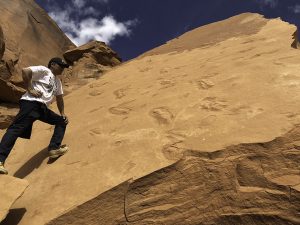‘Spectacular’ discovery gives rare view of walking dinosaurs
May 23, 2018, 10:20 PM | Updated: 11:47 pm
LAKE POWELL — When veteran dinosaur tracker Andre Delgalvis first laid eyes on a giant slab of rock near Lake Powell a few weeks ago, he could hardly believe what he was seeing.
“This is something very, very special,” he said later about his remarkable discovery.
It is obvious — even to an untrained eye — that the huge rock was crisscrossed by dinosaurs millions of years ago. The slab’s ancient secrets were evidently withheld for eons until a recent rockfall brought dozens of dinosaur tracks into view. That recent thunderous event apparently stood the rock up vertically, facing the lake, for anyone to see. It’s a page from the past, tipped up for easy reading.
Delgalvis is not unfamiliar with dinosaur tracks. He’s spent years cruising Lake Powell and hiking its shoreline. In the last two decades, he said, he’s found “thousands” of ancient footprints. He’s truly written the book on the topic; several years ago he published a coffee-table book featuring his own photos from Lake Powell called “The Lost Tracks.”

A recent rockfall brought a dinosaur tracks on a rock slab near Lake Powell into view. Photo: Andre Delgalvis
While floating in one of Lake Powell’s bays on March 14, he made his biggest discovery yet.
“The sun was just at the right angle,” Delgalvis said. “It just illuminated this rock.”
He borrowed binoculars from a park ranger that day for a better look.
“And lo and behold, the block was just covered with dinosaur tracks,” he said in a recent interview.
When he hiked through some gnarly brush and up a steep slope of broken boulders to the slab, there was a big payoff.
“What we found was just an incredible treasure-trove of dinosaur tracks,” Delgalvis said.

A recent rockfall brought a dinosaur tracks on a rock slab near Lake Powell into view. Photo: Andre Delgalvis
On a recent return trip with a Deseret News reporter, the nearly vertical slab was in the shade at first. But it came to life just as the morning sun peeked around a corner of the rock. The side lighting created shadows that made the ancient tracks exceptionally visible. It’s a feast of dinosaur tracks on a slab estimated to be 52 feet wide and 68 feet high.
“The whole crew was just totally, totally, amazed at this,” Delgalvis recalled of that first close-up view.
He was accompanied that day by his nephew, Steve Dzelzgalvis, whose family uses a different spelling of the last name.
“My impression of the moment,” Dzelzgalvis said with a laugh, “was seeing the biggest smile I’d ever seen on the captain’s face, hah, hah.”

A recent rockfall brought a dinosaur tracks on a rock slab near Lake Powell into view. Photo: Andre Delgalvis
Because of worries that Lake Powell boaters might climb to the site and vandalize it, Delgalvis asked the Deseret News to keep the exact location secret.
Paleontologist Andrew Milner, who has visited the discovery, described it as “spectacular” in an email to the Deseret News. He wrote that he was “truly blown away” when he saw it and plans to return soon to create a 3D computer model of the slab.
“This is a really important site,” Milner wrote, “and it definitely has development potential for the public should the (National Park Service) agree to do so.”

Veteran dinosaur tracker Andre Delgalvis discovered a feast of dinosaur tracks — noted by the different colors — on a slab near Lake Powell on March 14, 2018. Photo: Andre Delgalvis
It’s hard to say how many dinosaurs left impressions on the rock. There are at least 96 footprints from several different animals walking in different directions.
“Yeah, I’m seeing one, two, three, four parallel lines,” Delgalvis said as he surveyed the slab’s trackways. The parallel lines of tracks were created as individual dinosaurs walked along and left a record of several consecutive steps. One reptile alone seems to have left 25 footprints in a single stroll about 200 million years ago.
At the time the dinosaurs left the tracks, Milner believes, they lived in a wind-blown desert resembling “the modern-day Sahara Desert in many ways both in appearance and climate.” He thinks they walked on an ancient sand dune that later fossilized into a block of Wingate sandstone. The sand dunes might have been pre-moistened by dew or rainfall.
“That would allow enough moisture on the surface for any animal that walked across to leave an impression,” Delgalvis said. “The sun would bake it, harden it, and that’s what we’re seeing. This is one of the only (trackway) blocks that I know of that is on a sand dune formation.”
“The track block,” Milner wrote, “shows a variety of animal behaviors that are rare to see alone, yet here we have them preserved on a single fallen block.”
Although scientific dating of the tracks has not been done yet, Milner believes the tracks were laid down roughly 200 million years ago near the beginning of the Jurassic period or possibly at the end of the Triassic.
Delgalvis believes the slab was originally part of a much higher cliff.
“Well, my conclusion is that this broke off and slid down within the last eight to 10 years,” he said while standing at the foot of the slab. “I explored this whole area eight to 10 years ago and, absolutely, this was not here.”











